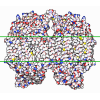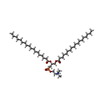+ Open data
Open data
- Basic information
Basic information
| Entry | Database: PDB / ID: 9j4x | |||||||||||||||||||||||||||||||||
|---|---|---|---|---|---|---|---|---|---|---|---|---|---|---|---|---|---|---|---|---|---|---|---|---|---|---|---|---|---|---|---|---|---|---|
| Title | CryoEM structure of human XPR1 in apo state | |||||||||||||||||||||||||||||||||
 Components Components | Solute carrier family 53 member 1 | |||||||||||||||||||||||||||||||||
 Keywords Keywords | TRANSPORT PROTEIN / Phosphate / Transport / XPR1 | |||||||||||||||||||||||||||||||||
| Function / homology |  Function and homology information Function and homology informationphosphate transmembrane transporter activity / phosphate ion transport / intracellular phosphate ion homeostasis / phosphate ion transmembrane transport / cellular response to phosphate starvation / inositol hexakisphosphate binding / efflux transmembrane transporter activity / response to virus / virus receptor activity / plasma membrane Similarity search - Function | |||||||||||||||||||||||||||||||||
| Biological species |  Homo sapiens (human) Homo sapiens (human) | |||||||||||||||||||||||||||||||||
| Method | ELECTRON MICROSCOPY / single particle reconstruction / cryo EM / Resolution: 2.9 Å | |||||||||||||||||||||||||||||||||
 Authors Authors | Zhang, W.H. / Chen, Y.K. / Guan, Z.Y. / Liu, Z. | |||||||||||||||||||||||||||||||||
| Funding support |  China, 1items China, 1items
| |||||||||||||||||||||||||||||||||
 Citation Citation |  Journal: Nat Commun / Year: 2025 Journal: Nat Commun / Year: 2025Title: Structural insights into the mechanism of phosphate recognition and transport by XPR1. Authors: Wenhui Zhang / Yanke Chen / Zeyuan Guan / Yong Wang / Meng Tang / Zhangmeng Du / Jie Zhang / Meng Cheng / Jiaqi Zuo / Yan Liu / Qiang Wang / Yanjun Liu / Delin Zhang / Ping Yin / Ling Ma / Zhu Liu /  Abstract: XPR1 is the sole protein known to transport inorganic phosphate (Pi) out of cells, a function conserved across species from yeast to mammals. Human XPR1 variants lead to cerebral calcium-phosphate ...XPR1 is the sole protein known to transport inorganic phosphate (Pi) out of cells, a function conserved across species from yeast to mammals. Human XPR1 variants lead to cerebral calcium-phosphate deposition and primary familial brain calcification (PFBC), a hereditary neurodegenerative disorder. Here, we present the cryo-EM structure of human XPR1 in both its Pi-unbound and various Pi-bound states. XPR1 features 10 transmembrane α-helices forming an ion channel-like structure, with multiple Pi recognition sites along the channel. Pathogenic mutations in two arginine residues, which line the translocation channel, disrupt Pi transport. Molecular dynamics simulations reveal that Pi ion undergoes a stepwise transition through the sequential recognition sites during the transport process. Together with functional analyses, our results suggest that this sequential arrangement allows XPR1 to facilitate Pi ion passage via a "relay" process, and they establish a framework for the interpretation of disease-related mutations and for the development of future therapeutics. | |||||||||||||||||||||||||||||||||
| History |
|
- Structure visualization
Structure visualization
| Structure viewer | Molecule:  Molmil Molmil Jmol/JSmol Jmol/JSmol |
|---|
- Downloads & links
Downloads & links
- Download
Download
| PDBx/mmCIF format |  9j4x.cif.gz 9j4x.cif.gz | 180.6 KB | Display |  PDBx/mmCIF format PDBx/mmCIF format |
|---|---|---|---|---|
| PDB format |  pdb9j4x.ent.gz pdb9j4x.ent.gz | 138.7 KB | Display |  PDB format PDB format |
| PDBx/mmJSON format |  9j4x.json.gz 9j4x.json.gz | Tree view |  PDBx/mmJSON format PDBx/mmJSON format | |
| Others |  Other downloads Other downloads |
-Validation report
| Summary document |  9j4x_validation.pdf.gz 9j4x_validation.pdf.gz | 557.1 KB | Display |  wwPDB validaton report wwPDB validaton report |
|---|---|---|---|---|
| Full document |  9j4x_full_validation.pdf.gz 9j4x_full_validation.pdf.gz | 570 KB | Display | |
| Data in XML |  9j4x_validation.xml.gz 9j4x_validation.xml.gz | 18.8 KB | Display | |
| Data in CIF |  9j4x_validation.cif.gz 9j4x_validation.cif.gz | 27.1 KB | Display | |
| Arichive directory |  https://data.pdbj.org/pub/pdb/validation_reports/j4/9j4x https://data.pdbj.org/pub/pdb/validation_reports/j4/9j4x ftp://data.pdbj.org/pub/pdb/validation_reports/j4/9j4x ftp://data.pdbj.org/pub/pdb/validation_reports/j4/9j4x | HTTPS FTP |
-Related structure data
| Related structure data |  61138MC  9j51C  9j52C  9j53C M: map data used to model this data C: citing same article ( |
|---|---|
| Similar structure data | Similarity search - Function & homology  F&H Search F&H Search |
- Links
Links
- Assembly
Assembly
| Deposited unit | 
|
|---|---|
| 1 |
|
- Components
Components
| #1: Protein | Mass: 84595.844 Da / Num. of mol.: 2 Source method: isolated from a genetically manipulated source Source: (gene. exp.)  Homo sapiens (human) / Gene: XPR1, SLC53A1, SYG1, X3 / Production host: Homo sapiens (human) / Gene: XPR1, SLC53A1, SYG1, X3 / Production host:  Homo sapiens (human) / References: UniProt: Q9UBH6 Homo sapiens (human) / References: UniProt: Q9UBH6#2: Chemical | ChemComp-PC1 / Has ligand of interest | N | Has protein modification | N | |
|---|
-Experimental details
-Experiment
| Experiment | Method: ELECTRON MICROSCOPY |
|---|---|
| EM experiment | Aggregation state: PARTICLE / 3D reconstruction method: single particle reconstruction |
- Sample preparation
Sample preparation
| Component | Name: Human XPR1 / Type: COMPLEX / Entity ID: #1 / Source: RECOMBINANT |
|---|---|
| Source (natural) | Organism:  Homo sapiens (human) Homo sapiens (human) |
| Source (recombinant) | Organism:  Homo sapiens (human) Homo sapiens (human) |
| Buffer solution | pH: 8 |
| Specimen | Conc.: 4.7 mg/ml / Embedding applied: NO / Shadowing applied: NO / Staining applied: NO / Vitrification applied: YES |
| Vitrification | Cryogen name: ETHANE |
- Electron microscopy imaging
Electron microscopy imaging
| Experimental equipment |  Model: Titan Krios / Image courtesy: FEI Company |
|---|---|
| Microscopy | Model: FEI TITAN KRIOS |
| Electron gun | Electron source:  FIELD EMISSION GUN / Accelerating voltage: 300 kV / Illumination mode: FLOOD BEAM FIELD EMISSION GUN / Accelerating voltage: 300 kV / Illumination mode: FLOOD BEAM |
| Electron lens | Mode: BRIGHT FIELD / Nominal defocus max: 2200 nm / Nominal defocus min: 1200 nm |
| Image recording | Electron dose: 50 e/Å2 / Film or detector model: GATAN K3 BIOQUANTUM (6k x 4k) |
- Processing
Processing
| EM software | Name: PHENIX / Category: model refinement | ||||||||||||||||||||||||
|---|---|---|---|---|---|---|---|---|---|---|---|---|---|---|---|---|---|---|---|---|---|---|---|---|---|
| CTF correction | Type: NONE | ||||||||||||||||||||||||
| Symmetry | Point symmetry: C1 (asymmetric) | ||||||||||||||||||||||||
| 3D reconstruction | Resolution: 2.9 Å / Resolution method: FSC 0.143 CUT-OFF / Num. of particles: 174844 / Symmetry type: POINT | ||||||||||||||||||||||||
| Refine LS restraints |
|
 Movie
Movie Controller
Controller






 PDBj
PDBj



